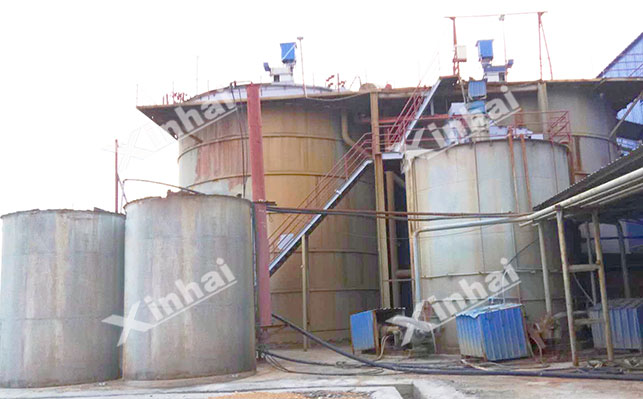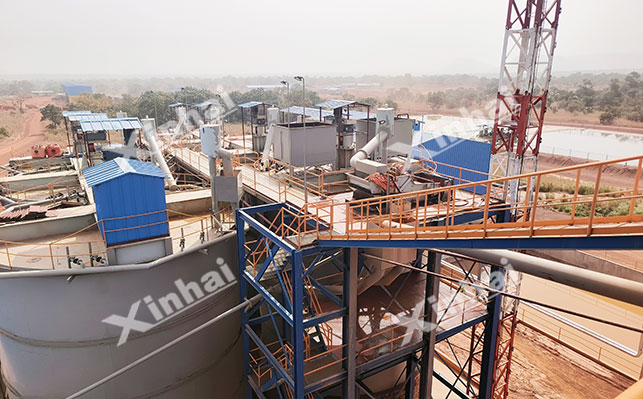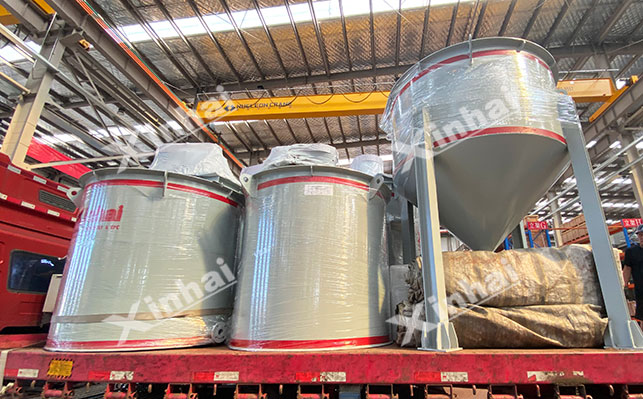
15311826613
Click to add WeChatIn the field of gold resource development, carbon slurry gold extraction technology is widely used because of its simple operation and strong adaptability. However, with the decline in the grade of gold mine resources and stricter environmental protection requirements, the traditional carbon slurry gold extraction process faces problems such as low gold recovery rate, high activated carbon consumption, and insufficient process efficiency. Based on the existing problems of carbon slurry gold extraction technology, this article introduces the optimization scheme of carbon slurry gold extraction technology from the aspects of pretreatment, leaching, adsorption, desorption electrolysis and activated carbon regeneration.

The carbon slurry gold extraction process is a combined gold extraction technology based on cyanide leaching and activated carbon adsorption. Generally, cyanide is first used to dissolve the gold in the ore into gold-cyanide complex in an alkaline environment, and then the gold-cyanide complex in the ore pulp is selectively adsorbed by the adsorption function of activated carbon to achieve the separation of gold from the ore pulp. Then the gold-loaded carbon is desorbed and electrolyzed to obtain gold ingots, and the activated carbon is regenerated and recycled to form a complete closed loop of gold extraction. The process flow is as follows:
Ore crushing and grinding: coarse and fine crushing by jaw crusher and cone crusher, and then grinding by ball mill to -200 mesh accounting for 70%-80%, so that the gold minerals are fully dissociated.
Cyanide leaching: cyanide is added to the alkaline slurry, and the gold is dissolved by stirring to form a gold-cyanide complex. The leaching time is usually 24-48 hours.
Activated carbon adsorption: the gold-loaded carbon is put into the adsorption tank, and it contacts with the leaching slurry in countercurrent to adsorb the gold-cyanide complex.
Desorption electrolysis: the gold is stripped from the gold-loaded carbon by high temperature and high pressure desorption method, and the desorption liquid is electrolytically deposited to obtain gold ingots.
Activated carbon regeneration: impurities on the surface of activated carbon are removed by high temperature roasting or chemical treatment to restore its adsorption performance.

As high-quality gold resources decrease, low-grade and complex gold mines have gradually become the focus of development, and traditional processes can no longer meet the needs of efficient extraction. At the same time, global environmental regulations are becoming stricter, forcing companies to optimize processes to reduce pollution. Therefore, improving the economy and environmental friendliness of carbon-in-slurry gold extraction through technological innovation and process optimization is of great significance to the sustainable development of the gold industry. The main problems of the current carbon-in-slurry gold extraction process are as follows:
Insufficient gold recovery rate: Insufficient ore pretreatment and improper leaching conditions result in the failure of some gold to be effectively dissolved or adsorbed, and the industry average recovery rate is only 85%-90%.
Large activated carbon consumption: The uneven quality of activated carbon, low regeneration efficiency, and impurities in the slurry contamination of activated carbon make the consumption of activated carbon per ton of ore reach 1.5-2.5kg.
Low process efficiency: The control of parameters in each link depends on manual experience, and the equipment matching is poor, resulting in limited overall processing capacity.
Increasing environmental pressure: The toxicity of cyanide and the rising cost of wastewater treatment have put traditional processes under higher environmental compliance pressure.
In the carbon pulp gold extraction process, the cyanide concentration, pH value, dissolved oxygen content in the leaching stage, the carbon pulp ratio and contact time in the adsorption stage, the temperature and pressure in the desorption stage, and other parameters all have a key impact on the final gold extraction index, and all have room for optimization.

Optimization of ore particle size control: adopt the "multi-stage crushing + efficient classification" process to refine the grinding particle size to -200 mesh accounting for more than 85%, improve the dissociation degree of gold; introduce hydrocyclones and high-frequency fine screens to form a closed-loop circulation to reduce over-crushing.
Improvement of grinding efficiency: optimize the ratio of ball mill steel balls, adopt the "large and small ball graded loading" technology; add new grinding aids (such as lignin sulfonate) to reduce the viscosity of the ore pulp and improve the grinding efficiency by 10%-15%.
Improvement of pretreatment reagent selection and addition method: For carbon-containing, arsenic-containing and other difficult-to-treat ores, biological oxidation or roasting pretreatment is used; the amount of lime and cyanide added is accurately controlled through the automatic dosing system to avoid reagent waste.
Cyanide concentration and pH value control: Use online pH sensor and cyanide concentration analyzer to adjust the amount of lime and cyanide added in real time, control the pH value fluctuation range within ±0.2, and ensure that the cyanide concentration is stable at a reasonable value.
Optimization of dissolved oxygen content: Use oxygen-enriched leaching technology to increase the dissolved oxygen concentration to 8-10 mg/L to accelerate the dissolution rate of gold; optimize the stirring blade structure to enhance the mixing effect of slurry and oxygen.
Adjustment of leaching time and stirring intensity: Determine the reasonable leaching time through kinetic experiments, and use variable frequency speed control agitator to dynamically adjust the stirring intensity according to the slurry concentration.

Optimization of activated carbon selection criteria: coconut shell-based activated carbon with a specific surface area of ≥1200m²/g and a strength of ≥95%, and pre-activation treatment to improve adsorption performance.
Adjustment of carbon-slurry ratio and contact time: dynamically adjust the carbon-slurry ratio to 1:80-1:120 according to the ore grade, and use multi-stage series adsorption towers to extend the contact time to 12-15 hours to improve the adsorption rate.
Optimization of series adsorption tower configuration: design a stepped adsorption tower, use large-particle activated carbon (8-12 mesh) for rough adsorption in the front stage, and use small-particle activated carbon (14-18 mesh) for deep adsorption in the back stage to reduce activated carbon wear.
Activated carbon gold loading monitoring technology: install an X-ray fluorescence analyzer to monitor the gold content of gold-loaded carbon online, and replace it in time when the gold loading reaches 800-1200g/t to avoid excessive adsorption loss of gold.
Research on high-efficiency desorbent formula: Development of "sodium hydroxide + sodium cyanide + potassium sodium tartrate" composite desorbent, under the conditions of 120℃ and 2MPa, the desorption time is shortened to 4-6 hours.
Desorption temperature and pressure control: Using intelligent temperature control system and pressure sensor, the desorption temperature fluctuation range is controlled within ±2℃, and the pressure is stabilized at the set value ±0.1MPa.
Electrolysis parameter optimization: Increase the current density of the electrolytic cell to 300-400A/m², add polyacrylamide flocculant to accelerate the precipitation of gold mud, and increase the electrolysis efficiency by 15%.
Improvement of precious liquid purification technology: Use ion exchange resin to remove impurities such as copper and zinc in precious liquid to prevent them from co-depositing with gold during the electrolysis process and improve the purity of gold ingots.

Optimization of thermal regeneration process: using a two-stage thermal regeneration furnace, one stage of 300-500℃ low-temperature carbonization to remove organic matter, and the second stage of 800-900℃ high-temperature activation to restore the pore structure, the regeneration efficiency is increased to more than 90%.
Activated carbon loss control: optimize the internal structure of the adsorption tower to reduce the friction of carbon particles; set up an automatic cleaning device for the carbon screen to prevent the blockage and loss of carbon particles.
High-efficiency leaching tank: use a combined leaching tank with mechanical stirring and air lifting to enhance the slurry mixing effect, and increase the unit volume processing capacity by 20%.

New adsorption tower: design a cross-flow moving bed adsorption tower to achieve continuous countercurrent adsorption of activated carbon and slurry, reducing the floor space by 30%.
Energy-saving desorption system: use a high-temperature and high-pressure desorption electrolysis system, reduce energy consumption by 40%, and increase desorption efficiency by 10%.
The improvement of the above-mentioned carbon slurry gold extraction process is based on the support of innovative equipment and automated control systems. In addition, online monitoring technology can be added, and online monitoring instruments such as cyanide concentration, pH value, dissolved oxygen, and gold content can be deployed to collect data in real time and upload them to the central control system; automatic adjustment of reagent addition, stirring speed, desorption temperature and other parameters can be implemented to achieve closed-loop control of the entire process.
Xinhai has more than 30 years of technical experience in gold ore dressing. It has an independent mining design institute, which can not only design according to Chinese standards, but also according to Australian JORC standards, Valmin specifications and Canadian NI43-101 standards. It has provided innovative processes for the dressing plant many times according to its conditions, such as gold oxidation primary mixed ore gravity selection + flash flotation process, high-grade granular gold dressing process, easy-to-grind and difficult-to-grind mixed gold ore dressing process, etc.
In addition, Xinhai can also provide services such as overall planning, detailed design, EPC construction implementation, etc. of intelligent mines to create intelligent and green mines and help the mining industry develop efficiently.